Gordon Grice's Blog, page 92
July 1, 2011
Elk Attacks
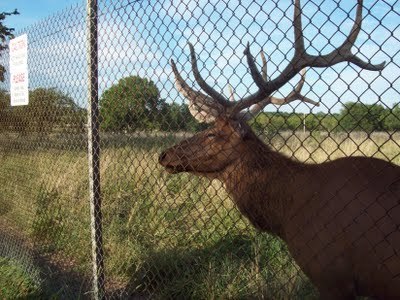 Captive elk photographed by Dee Puett
Captive elk photographed by Dee PuettThe Payson Roundup / Rogue elk attacks Payson woman:
This article tells of an unusual recent attack by a cow elk:
Lori Limebeer was treated and released at the hospital after a CT scan revealed that the blow to her head caused no brain injury, although she lost her recollection of the attack.
Even more interesting are the background stories it gives, like this one:
An elk gored a hunter to death as his wife filmed the incident. . . . The woman says that in retrospect she wished she had run to the truck to get the rifle, but she didn't want to break off filming the attack.
Published on July 01, 2011 10:02
June 30, 2011
June Bugs
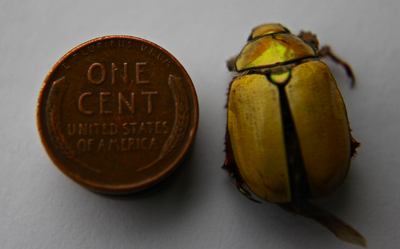
This beetle is one of many scarab species known by the common name junebug. A june bug typically has a long life as a grub—say, three years—followed by a brief, clumsy adulthood. Children in the South like to put them on leashes and let them whip around like tether balls.

Readers of The Red Hourglass may recall june bugs as the hapless victims of black widows. And tarantulas. And carabid beetles. And so on.
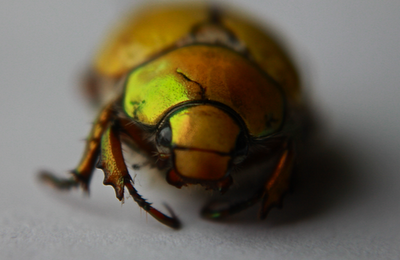
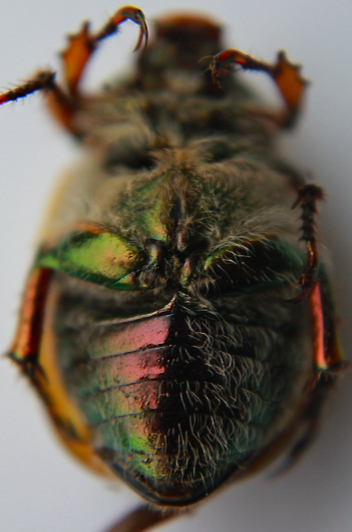

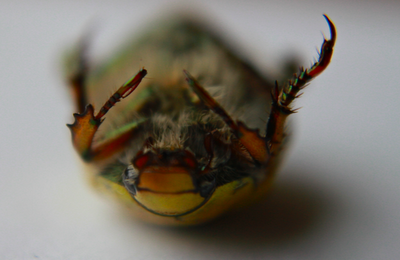
Photos by D'Arcy Allison-Teasley
Published on June 30, 2011 10:06
June 29, 2011
Rites of Spring: Fox Attacks
It's that time of year when a naturalist's thought turn to rabid foxes. Like most canids, foxes develop a manic form of the disease that makes them fearless and aggressive toward any other animals they happen to encounter, including humans. Normally, they avoid large, dangerous animals like us.

Published on June 29, 2011 12:09
June 28, 2011
Death Stories: Slice, Part 8

Go to the beginning of this story
I felt my scope gliding along the bone. I was seeing structures I'd previously known only vaguely from news stories about football players' knee injuries. The white pad of cartilage was the meniscus. The twist of meaty-looking fibrous tissue was the anterior cruciate ligament, or ACL. My scope slid off the bone and I was floating free in the fluid at the joint. I aimed the scope through the white architecture of bones to explore the ACL. Suddenly, without feeling any resistance, I had plunged through the ligament, doubtless crippling my patient for life.
"You can go through the ACL on this," Spitzer said. "We still need to work that out."
We had moved around a corner after the video display. What I'd just performed, badly, was a primitive kind of virtual surgery. The patient wasn't real; it was the digital ghost of Jernigan again, this time adapted for a machine that operates on the same idea as a flight simulator. The resistance I felt as I pressed against tissue, the palpable hardness of the bones, were supplied by a robot arm pushing against me as the computer directed. I watched my progress on a monitor, just as a surgeon does when he uses a scope. I could look down and see the knee where my hand felt it--an illusion accomplished by projecting the monitor's image to a screen beneath me.
Soon Spitzer took me to the basement. We passed through two sets of double metal doors to see the equipment. First, a dolly that had held the frozen corpses when they were sawed into four pieces. The tool with which Spitzer and his colleagues accomplished this task looked like nothing but an oversized hacksaw.
Then, into the cooler, which is an improvement: during Jernigan's sectioning, the work went on in an old facility without air-conditioning, and the temperature often reached 100. In this new set-up, the corpse and the cameras and the circular grinding head suspended from the ceiling are all in a refrigerated chamber. A technician sits in a booth outside, controlling the cameras and watching through the windows. We went into the chamber. It had the oily smell of a woodworking shop, minus the sawdust. The digital camera set-up looked curiously primitive, with black cloth draped in the manner of 19th century photography. There was a remote-controlled nozzle for spritzing the flesh with alcohol between shots and a remote-controlled airhose for brushing away the shavings. That, too, is an improvement; when Jernigan was sectioned, photographers had to be in the room hosing the flesh off by hand.
As all this continuing work implies, the University of Colorado group is far from finished with the digitizing of cadavers. Having satisfied the contract with the NLM, Spitzer's team went on to work with corporate sponsors. One result was the knee-surgery simulator. Another appears at first glance to be a human torso wedged into a box. It's actually a simulator that trains physicians to make injections into the celiac plexus, a tangle of nerves near the aorta. Such injections are used to relieve severe pain in, for example, terminally ill people. The trouble is that reaching the celiac plexus with a needle is a tricky procedure with considerable risks for the patient and few training opportunities for interns. The simulator lets the trainee feel a subtle aortic throb when she gets the needle to the right place.
Another simulator I encountered elsewhere allowed me to run a scope down the GI tract of a mannequin. It made realistic retching noises as I blundered about. The screen showed me a bleeding ulcer. I rammed the scope around, trying to get in position to cauterize the spurting wound. The patient moaned, retched, and lay silent. I had killed him.
Spitzer isn't content to simply develop applications for the two cadavers already made virtual. He spoke of taking 15,000 slices on the next cadaver, improving the detail of the Visible Human Female by a factor of three. He described the need for cadavers of every ethnicity and every body type, for women before and after menopause, for people of every age.
Shoving a gigantic floppy disk into a computer set-up, he revealed another accomplishment: a virtual fetus. Like Jernigan, the fetus moved toward the viewer, revealing itself in progressively deeper cuts.
You must have three additional drawings to show the anatomy of women, for the womb and fetus make much mysterious.
Leonardo da Vinci
The National Library of Medicine isn't finished with the idea either. Michael Ackerman, the biomedical engineer who put the project together, said work is continuing on sorting out the "artifacts" in the Visible Human data--for example, the slight distortions freezing produces in soft tissue. There are also problems with resolution; the tiny bones of the inner ear are too small to be seen in detail on the existing Visible Humans. Despite such problems, the virtual cadavers have already been used to design prosthetic limbs and as crash-dummies in simulations. Lawyers have used them to illustrate injuries in court cases. They've replaced real cadavers in some anatomy classes. The army is working toward using the data to simulate battle wounds, a need currently met by shooting up livestock.
Another idea in development is to combine MRI or CT images from a specific patient with the virtual bodies. The result would allow doctors to look at, and even practice on, simulations of their particular patients. ("Your doctor could practice on a virtual you," Spitzer told me, pointing emphatically to the vicinity of my sternum.) Since such images are transmissible, doctors could get long-distance help from specialists. Surgeons could operate on battlefield soldiers by remote.
Artists have incorporated Visible Human images in exhibited work. Ackerman told me about seeing the images displayed as holograms at the Maryland Science Center. He watched people watching the display. "I now know why a composer goes to a concert to hear his own music," he said.
Published on June 28, 2011 10:56
June 27, 2011
Death Stories: Slice, Part 7
Go to the beginning of this story

One of the sculptures is a man skinned and split longitudinally, his separate muscular halves standing a foot or so apart. Between the halves, his brain and spinal column are propped in mid-air. Attached to this central section in the appropriate places are his eyeballs and lungs. The rest of the viscera have been removed from their usual positions for clear viewing; the hands are holding them.
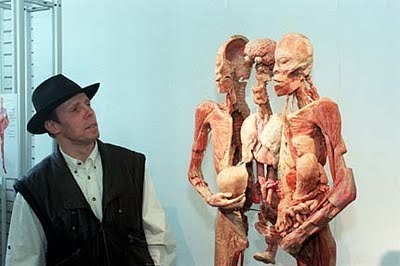
The "sculpture" is not a representation, but an actual human body infused with plastic, one of twenty in the exhibition. Another is a man posed as if running. He is naked to his muscles, and the muscles themselves peel open to show underlying structures--like bouquets of flowers, as their creator says. Besides more-or-less whole bodies, the exhibition contains two hundred other pieces, mostly sections or single organs. Some of these are healthy specimens--an inside view of the brain and nasal structures, for example. Others show pathologies--from brain hemorrhage to cirrhosis to constipation.
The man responsible is Gunther von Hagens, an East German refugee who was associated with the University of Heidelberg until 1998?, when he resigned to start his own company. In the late 1970s, Von Hagens found he could preserve human tissue through a high-tech process of infusion. His process replaced the water and fat cells in human flesh with polymers, leaving the tissues almost unchanged in appearance except for an added sheen--as if they had been laminated. Flesh so treated does not rot. Von Hagens estimates it will last 100,000 years.
Plastinated organs and body sections soon turned up in medical schools, mortuary schools, chiropractic training centers. Pathologists could keep plastinated organs--normal or diseased--on hand for comparison. Skeletons had always been available for study, and organs had been pickled and kept in museums and teaching hospitals, but von Hagens made it possible for any medical facility to have the necessary study specimens on hand--not models, but the real thing, and not pickled, but suitable for handling. They could be flexible or firm, depending on the recipe used. The only maintenance these plastinated pieces required was to be wiped clean after a few handlings. And unlike the plastic-encased "round steak" Vic Spitzer had showed me, von Hagens's specimens retained the color and shape of living organs.
Nobody objected to von Hagens's anatomical specimens as long as they stayed in strictly scientific settings. The trouble started when the good doctor discovered what he calls "gestalt plastination," a method of infusing a reasonably whole body. To complicate the issue, von Hagens stood the bodies up and posed them. They looked like sculpture. Von Hagens arranged for exhibitions in Europe, the US, and Japan, which combined to draw millions.
In Germany, Catholic and Protestant leaders pressured politicians to stop the shows. "He who styles human corpses as a so-called work of art no longer respects the importance of death," proclaimed Catholic theologian Johannes Reiter. The churches prefer to keep their "monopoly on burial," von Hagens explained. "I'm described as a Frankenstein." In Japan, people had no problem with the all-Caucasian exhibits until von Hagens mentioned his shocking ambition of plastinating a Japanese. Other objections came from fellow anatomists, who said the exhibits were too complex for the lay public. Most of his critics, von Hagens noted, had not actually seen his exhibitions. As a public event, von Hagens's installations had more in common with the photography of Robert Mapplethorpe than with anatomy texts.
I phoned von Hagens in Switzerland, where he was supervising a show, to ask him about these objections. His defense of his work took on political overtones. "It's democratic," he said. "The layman is given back what he lost 200 years ago." He referred to his own past in Communist East Germany; his current work, he said, is a form of "body liberation." The objections to his work are, in his view, not unlike the prudery that often attends sexual and excretory matters.
But seeing his exhibits is liberating in a deeper sense. Van Hagens describes rowdy teens who "come to see something ghostly, ugly," but instead fall silent with something like awe. "They find themselves anew," he adds. Viewers decide on the spot to donate their bodies, and von Hagens's people are happy to sign them up. One young woman even decided against suicide after seeing the exhibit.
All this sounds rather spiritual, but von Hagens doesn't deny that some see the exhibits and find them repellent. The showings average about one fainting per day. And there are some exhibits that a number of visitors choose to skip--mostly malformed fetuses, which von Hagens obtained as slowly degrading pickled specimens from medical schools and made permanent. Among the plastinated adults is a skinned woman with her womb opened to show the five-month-old fetus she was carrying.
Is this art, or just death imitating art? Von Hagens is careful about his answers. "I call it anatomy art--but the definition of art needs interpretation. It's an aesthetic, instructive presentation of the body's interior. It's enlightening science; it's between science and art. It produces feelings like art; many say it is art." People have compared his work to that of various artists, including the "exploded" anatomies of Dali, a resemblance von Hagens explains as similar challenges yielding similar solutions.
All right, then. Does he consider himself an artist? "I see myself as an inventor primarily." He says his methods are like those of an artist, and he's not afraid to use the word beautiful. "I always dissect in my mind," he said. The twenty full-size pieces in this exhibit represent only a third of his designs; the rest are not yet built. One unrealized project is two people spiral-cut and combined into one. Another, finished since our talk, was a skinless horse and rider. Horse and human look surprisingly similar beneath the hide.
His trepidation about the word "art" seems to stem from the objections others have raised, in which art is a disparaging term. Von Hagens wants his work seen as educational. He does not, he points out, try for "aesthetic shock" of the sort that would occur if he transformed a penis into a vulva or a face into a Halloween mask. His work is not transformation, but revelation.
Von Hagens maintains a taboo on individual identity. Although the plastinated organs and sections he sells to medical schools sometimes come from the homeless and others whose bodies fall into government hands, he performs sheet plastination only on those who specifically donate their bodies for that purpose. He changes their faces so they can't be recognized--one of the few alterations he allows himself (another is glass eyes: real ones don't preserve well).
"Anonymity is important to distinguish a mummy from a corpse," he says. More fine distinctions. A corpse is a known person, whose death is an occasion for mourning. A mummy is an educational exhibit, as well as a legacy. Von Hagens says his mummies will outlast the Egyptian ones, and adds: "To the future belong human remains."
I wish to work miracles. Maybe I'll have less than men with more peaceful lives, less than those who want to get rich in a day. I may live for a long time in great poverty, as always happens to alchemists, the would-be creators of gold and silver, and to engineers who would have dead water stir itself into life and perpetual motion, and to those supreme fools, the necromancer and the enchanter.
Leonardo da Vinci
Published on June 27, 2011 10:27
June 26, 2011
Raccoons in the City

Interesting article on raccoons interacting with humans in an urban environment.
"They are wild animals. They may look cute and cuddly, but a big raccoon is about as fearsome an animal as you'll ever run into," he said.
Like most wild animals, raccoons won't attack first unless they feel threatened or cornered, but they are more prone to it if they have kits. Larger males can be irritable but will usually direct their anger towards other animals, such as dogs or cats if they perceive them as the culprit of their dissatisfaction.
"Usually it's going to be the other animal. They may bluff charge sometimes and they'll definitely be vocal. They are a very vocal critter. But they are used to living with us," Lang said.
Published on June 26, 2011 10:43
June 25, 2011
Python Eats Dog
 Photo credit: One Dead President/Creative Commons
Photo credit: One Dead President/Creative CommonsIn the US, we occasionally hear of pets snatched by cougars or coyotes. In Australia . . . well, you'll see.
This snake is a scrub python, also called the amethystine python. Members of this species have occasionally attacked children, as discussed in Deadly Kingdom, but they are probably too slender to actually eat a human.
Related Post: Rock Python in a Fence
Published on June 25, 2011 08:30
June 24, 2011
Predators among the Sardines
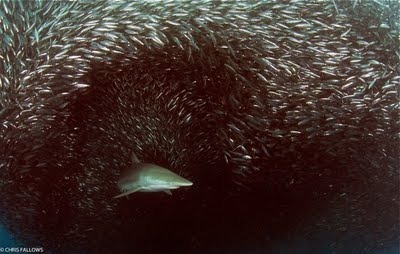
"All around you it is chaos," Fallows continues. "Dolphin squadrons, shark battalions and kamikaze gannets all attack, creating an almost dizzying underwater ballet of piscine gluttony."
Interesting article about sardine runs off South Africa.
Published on June 24, 2011 08:23
June 23, 2011
Zoo Lion Interested in Baby
Cute or terrifying? You decide:
And while we're at it, here's an annoyingly manipulated but otherwise fascinating video along the same line:
(Thanks to Greyson for the tip.)
And while we're at it, here's an annoyingly manipulated but otherwise fascinating video along the same line:
(Thanks to Greyson for the tip.)
Published on June 23, 2011 06:29
June 21, 2011
Death Stories: Slice, Part 6

Go to the beginning of this story
The interior of the corpse became an object of public curiosity. In 1632 the surgeons' guild responsible for the public dissection of a petty criminal commissioned Rembrandt to paint the event. The result was his group portrait Doctor Nicolaes Tulp Demonstrating the Anatomy of the Arm. It was roughly the equivalent of putting an Elk's Club fund-raiser in the newspaper today. This was not Rembrandt's only painting of a dissection, nor was he the only artist to incorporate graphic autopsies in his work. The dissection became, in fact, a minor subgenre spanning periods and styles, attempted by a range of artists familiar (Eakins, Hogarth) and otherwise.
 Hogarth
HogarthAbout two hundred years ago, dissection went underground--or, at least, into the academy and the hospital, rarely to be seen by the layman. This circumstance was part of a general cultural trend toward hiding life's unpleasantries; it presaged the rise of the funeral industry, which obviated the necessity for most people to handle the dead. The secrecy varnished dissection with a fresh coat of the sinister, as evidenced by such fictional horrors as Frankenstein. This novel, published in 1818, resurrects the Faust myth in anatomical terms.
It was on a dreary night of November that I beheld the accomplishment of my toils. With an anxiety that almost amounted to agony, I collected the instruments of life around me, that I might infuse a spark of being into the lifeless thing that lay at my feet. It was already one in the morning; the rain pattered dismally against the panes, and my candle was nearly burnt out, when, by the glimmer of the half-extinguished light, I saw the dull yellow eye of the creature open; it breathed hard, and a convulsive motion agitated its limbs.
His limbs were in proportion, and I had selected his features as beautiful. Beautiful! Great God! His yellow skin scarcely covered the work of muscles and arteries beneath; his hair was of a lustrous black, and flowing; his teeth of a pearly whiteness; but these luxuriances only formed a more horrid contrast with his watery eyes, that seemed almost of the same colour as the dun-white sockets in which they were set, his shrivelled complexion and straight black lips.
Mary Shelley
Another indicator of public unease on anatomical matters was the case of Burke and Hare. These resourceful men made money by supplying corpses, often stolen from graves, to medical students. Burke and Hare weren't the only "resurrection men" of their day. What set them apart was their eminently logical shortcut of murdering people instead of digging them up. This method was not only more efficient than scouting out and disenterring the recently dead, but it also, in an unforeseen benefit for their possibly unwitting buyers, produced fresher specimens. Burke even developed the habit of killing by suffocation so as to leave the corpses undamaged. Robert Louis Stevenson fictionalized their case in "The Body Snatchers."
The Resurrection Man--to use a by-name of the period--was not to be deterred by any of the sanctities of customary piety. It was part of his trade to despise and desecrate the scrolls and trumpets of old tombs, the paths worn by the feet of worshippers and mourners, and the offerings and the inscriptions of bereaved affection. To rustic neighbourhoods, where love is more than commonly tenacious, and where some bonds of blood or fellowship unite the entire society of a parish, the body-snatcher, far from being repelled by natural respect, was attracted by the ease and safety of the task. To bodies that had been laid in earth, in joyful expectation of a far different awakening, there came that hasty, lamp-lit, terror-haunted resurrection of the spade and mattock. The coffin was forced, the cerements torn, and the melancholy relics, clad in sackcloth, after being rattled for hours on moonless byways, were at length exposed to uttermost indignities before a class of gaping boys.
Somewhat as two vultures may swoop upon a dying lamb, Fettes and Macfarlane were to be let loose upon a grave in that green and quiet resting-place. The wife of a farmer, a woman who had lived for sixty years, and been known for nothing but good butter and a godly conversation, was to be rooted from her grave at midnight and carried, dead and naked to that far-away city that she had always honoured with her Sunday's best; the place beside her family was to be empty till the crack of doom; her innocent and almost venerable members to be exposed to that last curiosity of the anatomist.
Robert Louis Stevenson
The scandal that resulted from the Burke and Hare case stirred up that near-supernatural dread of the medical profession which seems to be always potential in our culture. It's also a revealing indicator of our attitudes toward the bodies of the dead. Even though being buried in the ground is a sure way to destroy a body through rot (even if it's embalmed), we find it uniquely objectionable if someone steals a corpse or its parts, destroying the body in some other way. On the whole, though, the Western world was silent about dissection until the end of the 20th century, when new technologies suddenly made anatomy more available to the average person than it ever had been. Now surgeries could be viewed on cable TV or on the internet.
The paradoxical power of the internet to both democratize and depersonalize has never been clearer than in the case of the Visible Humans. Jernigan and his anonymous female counterpart are the most intensely known human bodies in the world. But, because they have been converted to data, their bodies don't seem to invoke the taboo against dealing with corpses; they've been dehumanized. When they first announced the Visible Human Project to the public, the scientists involved prepared carefully for the press conference; they feared the whole idea would come across as macabre. They needn't have worried; many of the reporters who had come to the press conference left before it even began to cover a breaking story, the jail-house murder of amateur anatomist Jeffrey Dahmer. Those who remained handled it with equanimity.
Jernigan willed his body to medical science. He never knew he would become an object of public scrutiny. In the eyes of some observers, he has been violated on the largest scale imaginable. But if the promise of the Visible Human Project is realized, his violation will soon obviate the need for other human corpses to be cut open after death.
Human corpses, no matter how well preserved, will always lose the battle with decomposition, fungi, scavengers, and insects, even if it takes thousands of years. Even mummies that survive for millenia undergo drastic chemical and physical changes. But because Paul Jernigan and the virtual people to follow him have passed from the physical to the virtual, they may survive as long as human technology does.
Which brings us to another innovation in anatomy. But let's save that for the next installment.
Published on June 21, 2011 09:03



